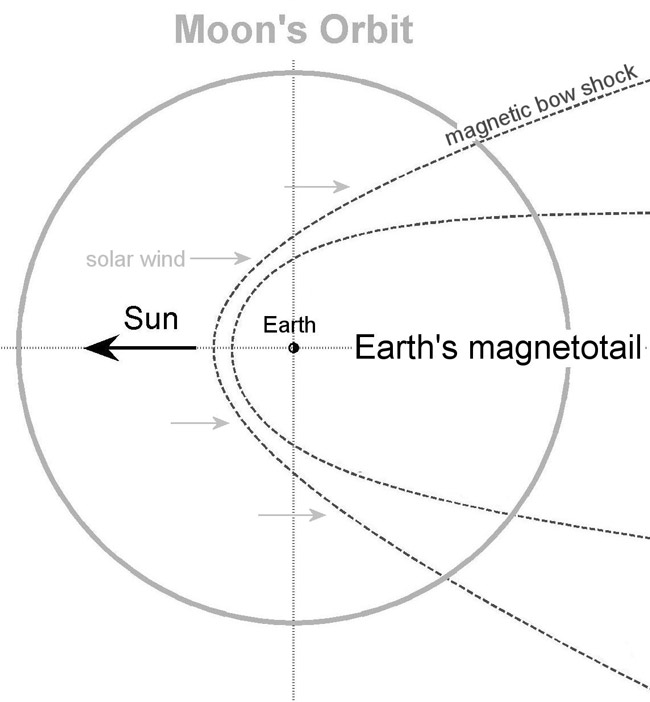Strange Things Happen at Full Moon

Full moonsare said to be behind many strange things, but here's one you didn't knowabout: At full moon, our favorite satellite is whipped by Earth's magnetotail, causing lunar dust storms anddischarges of static electricity.
Thisnew finding, announced this week by NASA, is important to future lunarexplorers: Astronauts may find themselves "crackling with electricity likea sock pulled out of a hot dryer," according to an agency statement.
Theeffect on the moon was first noticed in 1968, when NASA's Surveyor 7 landerphotographed a strange glow on the horizon after dark. Nobody knew what it was.Now scientists think it was sunlight scattered by electricallycharged moon dust floating just above the surface. That fits with data fromNASA's Lunar Prospector, which orbited the moon in 1998-99. During somecrossings of the magnetotail, the spacecraft recorded big changes in the lunarnight-side voltage.
How it works
Ourentire planet is enveloped in a bubble of magnetism generated by the rotatingcore. The solar wind, a stream of charged particles, pushes the bubble awayfrom the sun and creates a long tail of magnetized material downstream.
"Earth'smagnetotail extends well beyond the orbit of the moon and, once a month [atfull moon] the moon orbits through it," said Tim Stubbs, a University of Maryland scientist working atthe Goddard Space Flight Center. "This can have consequences ranging fromlunar 'dust storms' to electrostatic discharges."
Here'swhat Stubbs and colleagues now think is happening:
Get the Space.com Newsletter
Breaking space news, the latest updates on rocket launches, skywatching events and more!
Atfull moon, the moon passesthrough a huge "plasma sheet" — hot charged particles trapped in the tail.The lightest and most mobile of these particles, electrons, pepper the moon'ssurface and give the moon a negative charge, the researchers explained.
Onthe moon's dayside this effect is counteracted somewhat by sunlight: Photonsknock electrons back off the surface, lessening the negative charge. But on thenightside, electrons accumulate and the charge can climb to thousands of volts.
What happens
Theresearchers speculate on what happens next.
TheSurveyor 7 images suggest fine dust particles, all charged up, float above thelunar surface. On the night side, this dust might be intense enough to clogmachinery and scratch an astronaut's faceplate.
Theextreme differences in charge might cause dust to fly from the negative nightside to the less-negative day side, becoming strongest along the regions wherethe sun is rising or setting.
Wild place
NASAhas long been concerned about these electricalcharges and moon dust and the overall impacts on astronauts, habitats andmachinery. In fact theagency is drawingup plans to probe the secrets of moon dust.
Astronautswalking on the charged terrain might get electrified like sock from a hotdryer. "Touching another astronaut, a doorknob, a piece of sensitiveelectronics — any of these simple actions could produce an unwelcome zap."
"Propergrounding is strongly recommended," Stubbs advised.
Theplasma sheet is in a constant state of motion, flapping up and down all thetime," said Jasper Halekas of the University of California, Berkeley. "So as the moon orbits through the magnetotail,the plasma sheet can sweep across it over and over again. Depending on howdynamic things are, we can encounter the plasma sheet many times during asingle pass through the magnetotail with encounters lasting anywhere fromminutes to hours or even days."
Thismakes for a very dramatic environment.
"Themoon can be just sitting there in a quiet region of the magnetotail and thensuddenly all this hot plasma goes sweeping by, causing the night side potentialto spike to a kilovolt," Halekas said. "Then it drops back again justas quickly."
Anyoneon the moon would want to know more about how all this works. And it'd besignificantly worse during a solar storm.
"Thatis a very dynamic time for the plasma sheet and we need to study what happensthen," he says.
- Gallery: Lunar Images
- Full Moon Fever: News, Images and Lore
- Does the Full Moon Make People Crazy?
Join our Space Forums to keep talking space on the latest missions, night sky and more! And if you have a news tip, correction or comment, let us know at: community@space.com.

Space.com is the premier source of space exploration, innovation and astronomy news, chronicling (and celebrating) humanity's ongoing expansion across the final frontier. Originally founded in 1999, Space.com is, and always has been, the passion of writers and editors who are space fans and also trained journalists. Our current news team consists of Editor-in-Chief Tariq Malik; Editor Hanneke Weitering, Senior Space Writer Mike Wall; Senior Writer Meghan Bartels; Senior Writer Chelsea Gohd, Senior Writer Tereza Pultarova and Staff Writer Alexander Cox, focusing on e-commerce. Senior Producer Steve Spaleta oversees our space videos, with Diana Whitcroft as our Social Media Editor.









